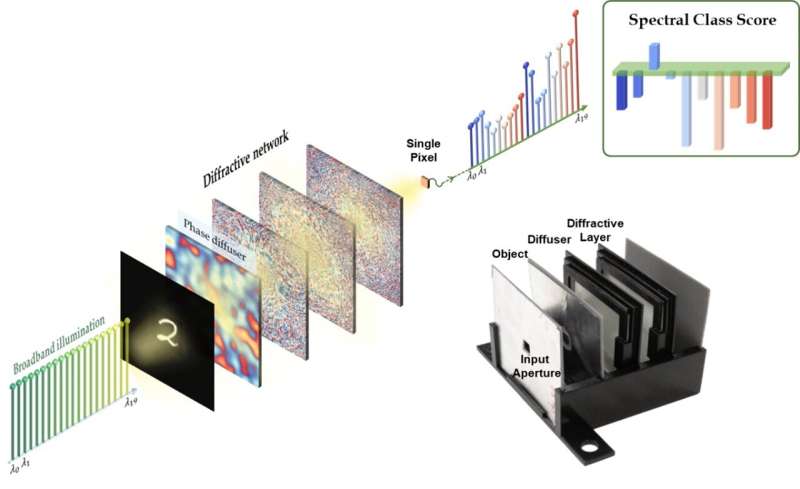This article has been reviewed according to Science X's editorial process and policies. Editors have highlighted the following attributes while ensuring the content's credibility:
fact-checked
peer-reviewed publication
trusted source
proofread
Optical computing for object classification through diffusive random media

Object recognition through random scattering media has been an important but challenging task in many fields, such as biomedical imaging, oceanography, security, robotics, and autonomous driving. Numerous computational solutions have been developed to address this problem. However, all of these require large-scale digital computing and consume significant amounts of energy, while still lacking generalization to new random diffusers never used in the training phase.
Researchers at UCLA have recently developed an all-optical method that enables objects to be classified through unknown random diffusers using diffractive deep neural networks (D2NNs). D2NNs form a free-space optical computing platform that has attracted growing research interest in recent years.
D2NNs compute a given task by modulating the light diffraction through a series of spatially structured surfaces, collectively forming an all-optical computer that can operate at the speed of light. Such an all-optical computing framework has the benefits of high speed, parallelism and low power consumption and could be useful in many computing tasks, such as object classification, quantitative phase imaging, microscopy, universal linear transformations, etc.
Published in Light: Science & Applications, this research paper, titled "All-optical image classification through unknown random diffusers using a single-pixel diffractive network," presented a new method that uses broadband diffractive networks to directly classify unknown objects through unknown, random diffusers using a single-pixel spectral detector.
This broadband diffractive network architecture uses 20 discrete wavelengths to map a diffuser-distorted object into a spectral signature detected through a single pixel. During the training, many randomly generated phase diffusers were used to help the generalization performance of the diffractive optical network. After the deep learning-based training process, which is a one-time effort, the resulting diffractive layers can be physically fabricated to form a single-pixel network that classifies objects completely hidden by new, unknown random diffusers never seen during the training.
In their simulations, this single-pixel broadband diffractive network successfully recognized handwritten digits through randomly selected unknown phase diffusers with a blind testing accuracy of 87.74%. Furthermore, the researchers experimentally demonstrated the feasibility of this single-pixel broadband classifier using a 3D-printed diffractive network and a terahertz time-domain spectroscopy system. This optical computing framework can be scaled with respect to the illumination wavelength to operate at any part of the electromagnetic spectrum without redesigning or retraining its layers.
The research was led by Dr. Aydogan Ozcan, Chancellor's Professor and Volgenau Chair for Engineering Innovation at UCLA and HHMI Professor with the Howard Hughes Medical Institute. "This work constitutes the first demonstration of all-optical classification of objects through random diffusers that generalizes to new unknown diffusers," said Dr. Ozcan, "and we believe that this research will have an impact on developing faster, more efficient, and scalable object/image classification technologies through random diffusive media, which could benefit a wide range of fields, from health care and biomedicine to telecommunications and aerospace."
More information: Bijie Baiet al, "All-optical image classification through unknown random diffusers using a single-pixel diffractive network," Light: Science & Applications (2023). DOI: 10.1038/s41377-023-01116-3. www.nature.com/articles/s41377-023-01116-3
















